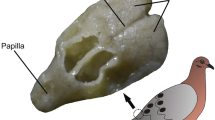Summary
The structure of a bulbous swelling near the haptonema base inChrysochromulina chiton is shown to possess some unique features interpreted as (a) mechanically significant in maintaining stability of the organelle as a whole and (b) functionally significant with respect to control of its movements. Identical structural features have been detected inPrymnesium parvum in a comparable position though this is not marked externally by a swelling. Below this region continuity has been demonstrated in both organisms between the haptonema cavity and a layer of superficial endoplasmic reticulum within the cell. Finally the numerical and geometrical changes affecting the axial tubes or fibres of the haptonema inC. chiton after entry into the subtending cytoplasm have been shown to agree precisely with those already traced in a similar position inPrymnesium parvum. In both organisms the haptonema starts at the extreme base as a close-packed group of 9 tubes or fibres which becomes reduced to 8 and eventually to 7 during growth towards the cell surface; thereafter an arc of 7 and eventually a ring of 7 tubes or fibres constitutes the core of the main free part of the organelle irrespective of its length. At the distal tip in both organisms the haptonema cavity passes over the rounded end of the core without other elaboration.
Similar content being viewed by others
References
Lackey, J. B., 1939: Notes on plankton flagellates from the Scioto River. Lloydia2, 128–143.
Lom, J., andE. N. Kosloff, 1967: The ultrastructure ofPhalacroleptes verruciformis, an unciliated ciliate parasitizing the polychaeteSchizobranchia insignis. J. Cell Biol.33, 355–364.
Manton, I., 1964 a: Observations with the electron microscope on the division cycle in the flagellatePrymnesium parvum Carter. J. Roy. Microscop. Soc.83, 317–325.
—, 1964 b: Further observations on the fine structure of the haptonema inPrymnesium parvum. Archiv f. Mikrobiol.49, 315–330.
—, 1964 c: Observations on the fine structure of the zoospore and young germling ofStigeoclonium. J. Exp. Bot.15, 399–416.
—, 1966 a: Further observations on the fine structure ofChrysochromulina chiton, with special reference to the pyrenoid. J. Cell Sci.1, 187–192.
—, 1966 b: Observations on scale production inPrymnesium parvum. J. Cell Sci.1, 375–380.
—, 1967 a: Further observations on the fine structure ofChrysochromulina chiton with special reference to the haptonema, “peculiar” Golgi and aspects of scale production. J. Cell Sci.2, 265–272.
—, 1967 b: Further observations on scale formation inChrysochromulina chiton. J. Cell Sci.2, 411–418.
—, andK. Harris, 1966: Observations on the microanatomy of the brown flagellateSphaleromantis tetragona Skuja with special reference to flagellar apparatus and scales. J. Linn. Soc.59 (Bot.), 397–403.
—, andG. F. Leedale, 1961 a: Further observations on the fine structure ofChrysochromulina ericina Parke and Manton. J. mar. biol. Ass. U.K.41, 145–155.
— —, 1961 b: Further observations on the fine structure ofChrysochrcromulina-kappa andChrysochromulina minor, with special reference to the pyrenoids. J. mar. biol. Ass. U.K.41, 519–526.
— —, 1963 a: Observations on the fine structure ofPrymnesium parvum Carter. Archiv f. Mikrobiol.45, 295–303.
— —, 1963 b: Observations on the micro-anatomy ofCrystallolithus hyalinus Gaarder and Markali. Archiv f. Mikrobiol.47, 115–136.
Parke, M., J. W. G. Lund, andI. Manton, 1962: Observations on the biology and fine structure of the type species ofChrysochromulina (C. parva Lackey) in the English Lake District. Archiv f. Mikrobiol.42, 333–352.
Parke, M., I. Manton, andB. Clarke, 1955: Studies on marine flagellates: II. Three new species ofChrysochromulina. J. mar. biol. Ass. U.K.34, 579–609.
— — —, 1958: Studies on marine flagellates: IV. Morphology and microanatomy of a new species ofChrysochromulina. J. mar. biol. Ass. U.K.37, 209–228.
Tilney, L. G., andK. R. Porter, 1965: Studies on the microtubules in heliozoa. I. The fine structure ofActinosphaerium nucleofilum (Barrett), with particular reference to the axial rod structure. Protoplasma60, 317–344.
— —, 1967: Studies on the microtubules in heliozoa. II. The effect of low temperature on these structures in the formation and maintenance of the axopodia. J. Cell Biol.34, 327–343.
Author information
Authors and Affiliations
Rights and permissions
About this article
Cite this article
Manton, I. Further observations on the microanatomy of the haptonema inChrysochromulina chiton andPrymnesium parvum . Protoplasma 66, 35–53 (1968). https://doi.org/10.1007/BF01252523
Received:
Issue Date:
DOI: https://doi.org/10.1007/BF01252523




